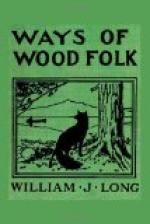While all this careful training is going on at home, the drake is off on the lakes somewhere with his boon companions, having a good time, and utterly neglectful of parental responsibility. Sometimes I have found clubs of five or six, gay fellows all, living by themselves at one end of a big lake where the fishing was good. All summer long they roam and gad about, free from care, and happy as summer campers, leaving mother birds meanwhile to feed and educate their offspring. Once only have I seen a drake sharing the responsibilities of his family. I watched three days to find the cause of his devotion; but he disappeared the third evening, and I never saw him again. Whether the drakes are lazy and run away, or whether they have the atrocious habit of many male birds and animals of destroying their young, and so are driven away by the females, I have not been able to find out.
These birds are very destructive on the trout streams; if a summer camper spare them, it is because of his interest in the young, and especially because of the mother bird’s devotion. When the recreant drake is met with, however, he goes promptly onto the bill of fare, with other good things.
Occasionally one overtakes a brood on a rapid river. Then the poor birds are distressed indeed. At the first glimpse of the canoe they are off, churning the water into foam in their flight. Not till they are out of sight round the bend do they hear the cluck that tells them to hide. Some are slow in finding a hiding place on the strange waters. The mother bird hurries them. They are hunting in frantic haste when round the bend comes the swift-gliding canoe. With a note of alarm they are all off again, for she will not leave even the weakest alone. Again they double the bend and try to hide; again the canoe overtakes them; and so on, mile after mile, till a stream or bogan flowing into the river offers a road to escape. Then, like a flash, the little ones run in under shelter of the banks, and glide up stream noiselessly, while mother bird flutters on down the river just ahead of the canoe. Having lured it away to a safe distance, as she thinks, she takes wing and returns to the young.
Their powers of endurance are remarkable. Once, on the Restigouche, we started a brood of little ones late in the afternoon. We were moving along in a good current, looking for a camping ground, and had little thought for the birds, which could never get far enough ahead to hide securely. For five miles they kept ahead of us, rushing out at each successive stretch of water, and fairly distancing us in a straight run. When we camped they were still below us. At dusk I was sitting motionless near the river when a slight movement over near the opposite bank attracted me. There was the mother bird, stealing along up stream under the fringe of bushes. The young followed in single file. There was no splashing of water now. Shadows were not more noiseless.




